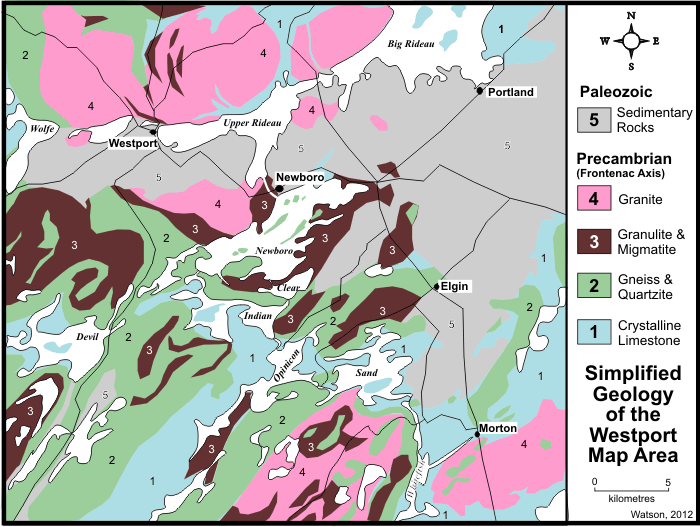 |
This highly simplified geology map shows some of the contact area between the Frontenac Axis
(units 1, 2, 3 and 4) and the younger sedimentary rocks (unit 5) in the central Rideau area.
Map adapted from GSC Map 1182A by H.R. Wynne-Edwards, GSC Memoir 346, 1967.
|
RIDEAU ROCK TYPES
Limestone - Known as crystalline limestone it is really a coarsely crystalline calcite marble. This rock is soft and has been eroded more deeply than other rocks, and therefore forms the basins for most of the large lakes of the region. In many areas it is almost pure calcium carbonate, although inclusions are very common. These can include varying amounts of graphite, and silicate minerals such as serpentine, quartz, phlogopite and feldspar. In some areas, dolomitic limestone is present. In the region around Charleston Lake, silicious crystalline limestone can be found, usually adjacent to the quartzite units.
Gneiss and Quartzite - Quartzite is a "silica flooded" metamorphic rock. The high silica content and the way it is incorporated into the rock makes it very hard. It is the hardest rock in the region and therefore forms many of the ridge tops in areas where it is present. Its origins are sedimentary, most likely sandstone, and in some places original sedimentary features such as bedding and crossbedding can be observed.
Gneiss is a generic descriptive term for a metamorphic rock with discontinuous visible layering (foliation) which occurs when groups of platy or elongate grains in separate lenses or streaks. It will often had differential colouring with alternating streaks/bands of light and dark minerals. In the Rideau Lakes region it is the most abundant rock after crystalline limestone. The most common units are a quartz-feldspar gneiss and a quartz-biotite-feldspar gneiss. In many areas, the metamorphism has introduced metamorphic minerals such as garnet (pink to dark red in crystals up to 2 inches in diameter) and cordierite (dark blue pods and segregations about 1 inch long).
Granulite and Migmatite - A granulite is an almost structureless quart-feldspar rock. It can be distinguished from gneiss by its generally lighter colour (almost no dark minerals) and the almost complete absence of foliation (layering). A migmatite is a metamorphic rock with a mixed structure, that usually results from the mixing of metamorphic and igneous material. Thus it is commonly found in proximity to the intrusive units (granites) and may represent re-melting of the original gneissic units.
Granite and Gabbro - Several igneous rock units occur in the area, the main ones being granitic units which range in composition from monzonite to quartz-monzonite. They are light in colour, generally coarse grained, and contain reddish-pink feldspar.
The other igneous rocks are gabbro and diorite, both dark coloured intrusive rocks. The diorite is a greenish-grey medium grained rock, although coarse grained sections can occur. The gabbro is generally medium grained, with a greenish brown colour.
Palaeozoic Sedimentary Rocks - These are the youngest rocks in the area, of Upper Cambrian to Middle Ordovician age (450 to 500 million years ago). Most of the units are flat lying, often lying unconformably over the tilted and folded Precambrian rock units. The lowermost unit is the Nepean Sandstone, a buff coloured sandstone which in some places contains a quartz-pebble conglomerate. It is overlain by the March and Oxford formations consisting of sandy dolomite, dolomite, and limestone. The uppermost unit is the Ottawa formation, consisting of sandy shale, fine grained grey limestone, and sandy limestone.
CREDITS: The map is a digital compilation of Geological Survey of Canada Map 1182A, "Geology, Westport, Ontario" which is part of GSC Memoir 346, by H.R. Wynne-Edwards, published in 1967.
|